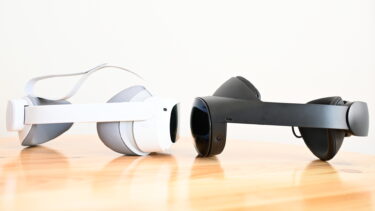Quest Pro Review: How good is Meta's first XR headset?
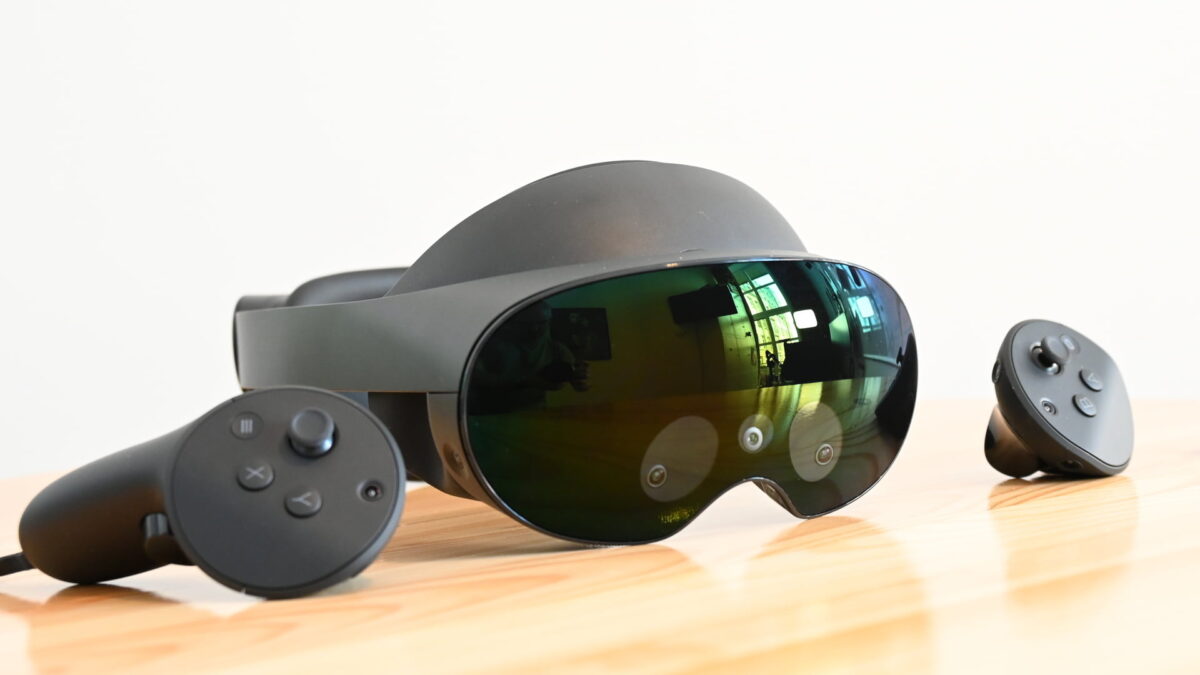
Meta markets the Quest Pro at professionals. The headset brings dedicated Mixed Reality for the first time. But, is the high price justified?
With the Quest Pro (info), Meta launched a new high-end range of VR headsets. Met markets the headset at professional users, developers, and companies. The headset is also a call for developers and a testing ground for the company's next consumer VR headset, the Quest 3.
Is the VR headset worthwhile for private users? How good is Meta Quest Pro? I tested the Quest Pro and these are my findings.
Content
Quest Pro test in a nutshell
The Quest Pro's image is, despite a minimal drop in resolution, much better than the image of the Quest 2 (review), and is sharp and clear from edge to edge. Colors are vibrant, the image is bright, and the contrast is sharp. However, I notice the screen-door effect more clearly than usual.
The Mixed Reality features are an impressive first iteration. Despite poor camera resolution, the color overlay including correct depth reproduction creates a good match between the look through the lenses and reality. Matching MR demos are mind-blowing, though distortions, poor resolution, and lagging hands/controllers prevent productive work on a monitor while wearing the Quest Pro.
The self-tracking Pro controllers are ergonomic and precise. Wi-Fi streaming via Air Link (guide) works well, as does the wired solution.
The non-replaceable head mount is stiff, but the attachment to the back of the head is pleasantly comfortable. In the front, the headset rests on the forehead, and that can be problematic. It bears the entire weight of the headset, which is heavy despite its cool form factor, and it presses uncomfortably on the forehead after a while.
The hefty $1,500 price makes the headset uninteresting for private users, except for early adopters and rich VR enthusiasts. In the professional sector and if you want to develop for the XR future, there is currently no standalone VR headset as good as the Quest Pro.
Meta Quest Pro is suitable for you if you …
- want to work with it professionally, for example in (mixed reality) app development,
- want to develop applications for eye- and face-tracking,
- need precise, self-tracking, and sharp, rich image
- want an excellent, sharp and rich image,
- want to hold the best virtual meetings up to this point because they are particularly realistic,
- are fully into Mixed Reality modes or experiences, and
- can easily spend $1,500.
Meta Quest Pro is not suitable for you if you …
- are looking for a particularly comfortable headset,
- are looking for a lightweight and customizable VR headset, for example with different head mounts,
- want a higher resolution than the Quest 2,
- expect perfect, high-resolution passthrough AR,
- want over two hours of battery life, and
- generally expects a sophisticated new generation of VR headsets.
Setup, configuration, and battery
Quest Pro is as easy to set up as Quest 2. Usage and safety instructions accompany the configuration of your VR area. The whole setup only takes me a few minutes. However, I did not succeed in pairing the Quest Pro with the Oculus app on the smartphone. Either an update is missing or I cannot find the Quest Pro in the device list despite the success message. That can be done much better.
Menus and settings are similar to the Quest 2. I can turn the new features like eye or face tracking on and off via the quick menu after activation, for example to save power.
The Quest Pro lasted for one and a half hours with changing applications, mostly in Mixed Reality mode. The Quest Pro can be charged via USB-C cable during use. Turning off MR and tracking options results in a Quest-2-like runtime of just over two hours. The VR headset can be recharged in just under two hours on the included docking station.
Christian Steiner, MIXED: There is no indication of the Pro features in the initial setup. No eye tracking calibration, no face tracking instruction. This made me realize once again that I'm not dealing with a gaming device here. Still, I would have expected a "Welcome to Quest Pro" demo after the high investment.
I find any complaint about battery life inappropriate. Battery life strongly depends on the applications here. In direct comparison to the Quest 2 with pure VR, I found that the battery lasts at least as long.
However, switching to passthrough AR and trying out mixed reality applications, you witness the battery consumption. It is clear that the passthrough technology in combination with infrared cameras, color cameras, and the AI magic putting all the data together into a stereoscopic VR image nibbles at battery life.
Quest Pro: Resolution, colors, refresh rate, screen-door effect
The Quest Pro has a minimally lower resolution of 1,800 x 1,920 pixels per eye than the Quest 2. Competing headset Pico 4 Enterprise (review) brings more to the display with 2,60 x 2,160.
However, the image of the Quest Pro still looks significantly clearer and sharper than Quest 2 due to the new pancake lenses that eliminate glare and god-rays. Colors are bright and rich, and contrast is strong. Black levels are better than the Quest 2, but not completely black.
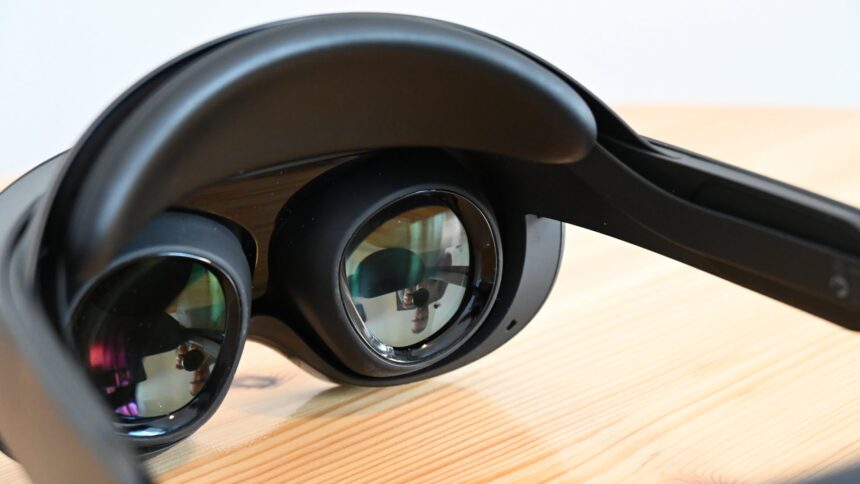
The Quest Pro's pancake lenses bring a very clear, rich image. | Image: MIXED
The refresh rate ranges from 72 to a maximum of 90 hertz. As with the Pico 4, I don't understand the downgrade. 90 Hz is the gold standard for VR and produces a smoother, more realistic, and more enjoyable image.
Similar to the Pico 4, I notice the screen-door effect immediately and clearly, more so than on Quest 2. However, unlike the competition, it is homogeneous, and I get used to it again fairly quickly. Apparently, the new lenses and image clarity make the screen-door effect stand out, at least for me.
The processing of the lenses is perfect. There is no ghosting, and no washed-out image due to internal reflections. In general, the VR headset makes a very high-quality impression.
Christian Steiner, MIXED: After months of using the Quest 2, I noticed the fantastic picture of the Quest Pro within the first few seconds. Great colors on OLED level, terrific sharpness, and overall better clarity of the picture due to a combination of local dimming, more pixels per inch, as well as pancake optics, make the picture impression one of the best currently on the market.
Field of view, sweet spot, IPD
The field of view is 106 degrees horizontally, which is 11 degrees larger than on the Quest 2. The flatter lenses also make the field of view feel larger because I'm closer to the display. This does not make a significant difference in practice, though.
The sweet spot is much more important. There is none. The image clarity from edge to edge remains sharp throughout - provided that the Quest Pro is worn correctly. I can automatically check the correct fit via eye-tracking.
The VR headset measures the interpupillary distance almost correctly after eye-tracking is activated - it missed one and a half millimeters of the distance measured by the optician. However, I have to move the lenses manually with my fingers from below between the face and the headset. That is neither elegant nor convenient, but it works.
Christian Steiner, MIXED: It took me a little while to get the headset comfortably on my head. Fortunately, I do not have to worry about a sweet spot. It's comfortably large for me as a non-glasses wearer. I wear the Quest Pro very close to my eyes, which gives me a great field of view, and the open design at the edges means I don't feel "cramped".
I was disappointed with the IPD adjustment. The eye-tracking "measures" the interpupillary distance and shows the "optimal" distance, but I have to reach into the headset from below to manually adjust it. That's not optimum. In addition, the displayed interpupillary distance due to the eye-tracking never exactly matched the interpupillary distance measured by an optician.
Quest Pro: eye-tracking and face-tracking
I would have expected eye-tracking to already be on during setup, measuring the interpupillary distance. Instead, I am only allowed to calibrate after activating it in the settings. Whether this is for privacy reasons (see the "Privacy" section for more information) or simply not thought through, I cannot say at this point. However, it makes little sense to me.
The calibration works well. In practice, for example in Horizon Workrooms or in a meeting in VR, the eye-tracking works well too. Viewing direction and blinking are mostly tracked and transmitted precisely.
The same applies to face-tracking. After I enabled it in the menu, lips and various movements of the lower half of the face transmit reasonably well. The more drastic the movements, the better the transmission. However, lip movements display relatively weakly on the avatar during normal speech behavior.
The face tracking makes for a more realistic virtual presence, but the transmission still has to improve. After all, no one wants to stress their facial muscles in a VR conversation that much just to get their avatar to visibly participate.
There are still no useful applications for both eye- and face-tracking. Some experimentation in workrooms and interactions with avatars in meeting rooms or the home environment is fine, but that is all at this point.
Christian Steiner, MIXED: There is no demo or decent functional testing for either feature. It's only in Meta's own meeting app, Workrooms (and Horizon Worlds, if you have access), that I get to watch my avatar grimace and wink in a tiny little mirror for the first time.
While the eye-tracking works solidly, the face-tracking is not particularly expressive. Exaggerated facial expressions display clearly, but I don't talk like that in a normal conversation. As soon as lips and facial expressions are "normal", my avatar does not produce more than a mumbling mouth.
Which brings me to the question: Is there any room for improvement, such as updates? Or is this iteration the best we can get at the moment?
Quest Pro: Passthrough & AR (Mixed Reality)
The color passthrough including correct depth representation is one of two top features of the XR headset. Normal movement in real space is possible without any problems, and the image also fits almost perfectly to the peripheral field of view at the edges of the half-open XR headset. Unlike the passthrough of Pico 4, I can walk around the apartment, climb stairs, and get things done normally without any caution.
Minor distortions and bulges in the image also occur occasionally. Furthermore, the RGB camera only overlays color on top of the monochrome stereo image from the tracking cameras. This is primarily noticeable close up and during faster movements when the color overlay can't keep up.
The resolution of the cameras is too low, and the image is very grainy depending on the lighting conditions. Reading text through the VR headset on screens is barely feasible, but hardly productive over a longer period of time. Unfortunately, this also eliminates one of the theoretically best use cases. A virtual multi-monitor setup with real monitors or a laptop is possible, but not yet useful due to the poor see-through resolution.
Whether Meta's own software or third-party programs like Immersed, Quest Pro nevertheless convinces me that virtual monitors in real space via headset are the future of productivity - as soon as technology and comfort are good enough.
The mixed reality concept also convinces me in demos and games. In "The World Beyond," a cuddly little alien bounces around my office.
Once I've drawn in walls and furniture (this doesn't happen automatically due to the missing depth sensor), the little thing runs around the desk, couch, and cabinet like a real pet. Additionally, I can dissolve my walls and turn them into portals, which transforms my room into a huge open world with meadows and trees and sky. In color, this is overwhelming and ranks on the same level as the wow effect of my first VR experience.
I also love the MR mode of games like Blaston, Cubism, or Puzzling Places. With an affordable XR headset, say a Quest 3 or maybe Pico 5, I could play Demeo with family and friends on the table in the living room.
In fact, this is already possible with the Quest Pro, as digital objects and text are sharp and clear, while color visibility is sufficient for the environment and people. You can find a number of excellent mixed reality apps for Quest Pro and Quest 2 in the linked article.
The social aspect is also impressive. When my colleague Christian visited me in the Meta Home environment, he floated around my office as an avatar. Our conversation was the most convincing virtual meeting so far, since it took place in my real environment.
Despite this experience, the technology is still in its infancy. The camera and image transfer to the video stream leave a lot to be desired. Hands or controllers lag quite a bit virtually. Not that I can't work with it, but it needs improvement. Quest Pro is by no means the perfect Mixed Reality headset that some people expected - it is just the first iteration.
Christian Steiner, MIXED: The headset struggles with overexposed areas in strong sunshine and grain in low light. There is also slight "wobble" at the edges of the various camera images. I was disappointed at first because I had expected much more.
During longer use, however, I realized what a technological feat is accomplished here. The image has such a well-functioning spatial representation that when wearing the headset in passthrough mode and without the light blockers on the sides, after a few minutes I can intentionally forget that I'm wearing an XR headset at all.
I was very impressed with how well the open design ensures that my peripheral field of view of the surroundings blends with Passthrough mode. I can move safely through my apartment, grab objects, and the fact that my arm is displayed almost flawlessly when I move it out of the peripheral field of view and into the digital image is phenomenal.
Of course, there are still errors, and it is far from perfect. Nevertheless, Meta shows impressively in which direction it is going. I see the potential, but not yet a finished 3D color view. Anyone who thought they'd get a finished technology suitable for everyday use with the first iteration hasn't understood the purpose of Quest Pro.
Quest Pro: Wearing comfort
The Quest Pro's wearing comfort ranks between good and poor, with a tendency toward the latter. Meta designed a rigid, non-interchangeable halo head mount, with a forehead pad above the visor, similar to Playstation VR.
At the back of the head is a mount similar to the Elite Strap for the Quest 2, but without gaps and made of soft rubber.
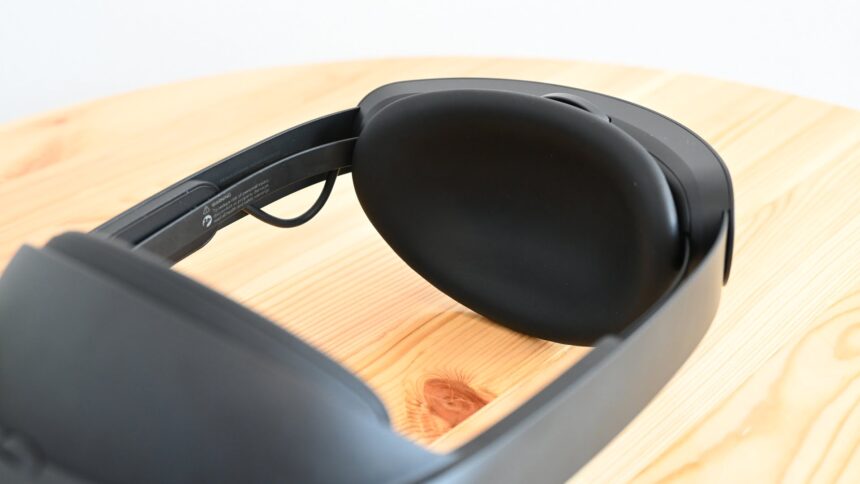
The rear head mount of the Quest Pro is quite soft and adapts to the back of the head. | Image: MIXED
While the rear head mount, which also houses the battery, works perfectly for me, the "forehead pad" is too narrow and, more importantly, poorly padded for my raised forehead.
Since the Quest Pro has no other fixing points at the front, the pressure on the forehead is so high, not least due to the weight (a pound-and-a-half heavier than the Quest 2 despite the thinner form factor) that it becomes uncomfortable after an hour at most, and leaves pressure marks.
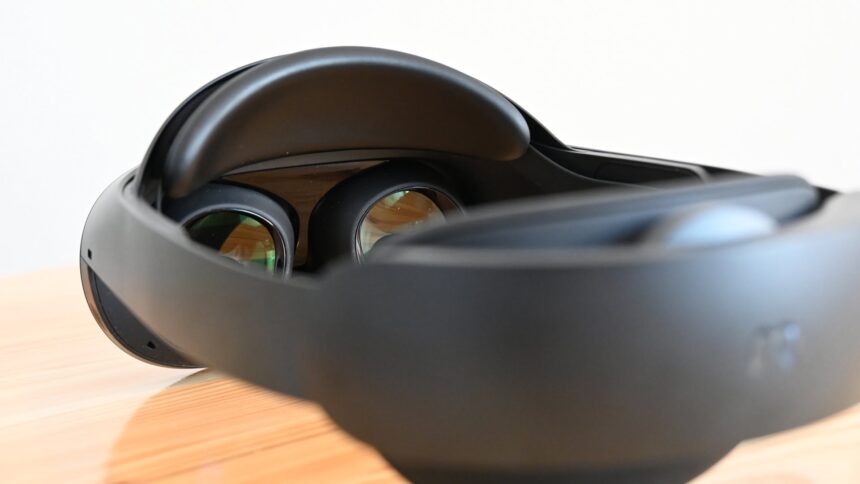
The forehead rest of the Quest Pro is the only fixing point on the front of the head. Since this pad is quite thin and narrow, it can become uncomfortable for people with a raised forehead after a longer session. | Image: MIXED
If I loosen the dial at the back of the head, I can take the pressure off, and then the Quest Pro is very comfortable for a while. But that only works up to a point, after all, the headset shouldn't sit too loosely. If I look upwards a lot, the weight of the VR headset causes unpleasant pressure on the forehead.
prescription glasses frames fit easily under the XR headset, which is open at the sides and bottom. If you want to focus on virtual reality, you can add light blockers on the right and left, which work surprisingly well. A full face gasket blocking all external light is not yet available, but launches soon for about $50. Considering the price of the Quest Pro, I find it quite absurd to demand so much money for a piece of rubber.
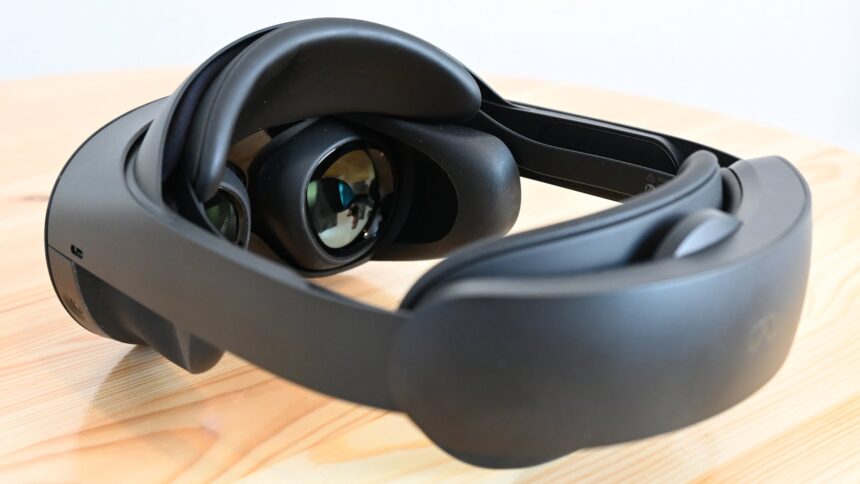
The lateral, magnetic light blockers shield the lenses of the Quest Pro and provide more focus on VR. A full light blocker must be purchased separately. | Image: MIXED
Christian Steiner, MIXED: Here, of all places, Meta failed in my opinion. The front pad presses on my forehead after about an hour. When I loosen the strap, the headset slides back and forth in front of my face too easily. I have to clamp the Quest Pro to my forehead and the back of my head like a vise.
I also find the permanently attached padding on the forehead a disaster. Once the forehead cover wears out, it apparently cannot be replaced. After a few months of heavy use, the forehead cover will be frayed without me being able to change it. A no-go for such an expensive device!
Hand tracking and redesigned controllers
Hand tracking works at least as well as in Quest 2, but it is still not perfect. It probably uses the same tracking cameras.
The new Pro controllers are the second top feature of the Quest Pro. The controllers track themselves via cameras. They no longer have a tracking ring and are more compact than the Touch controllers. They now track everywhere, even behind the body.
Even though the Quest Pro is not aimed at gamers, Beat Saber shows the advantages of the new controllers very well. The tracking remains stable even in higher difficulty levels and during fast lateral movements. I performed significantly better than usual. Beat Saber fans might consider the expensive investment of $300 for the Pro controllers supposedly compatible with the Quest 2 starting December 2022.
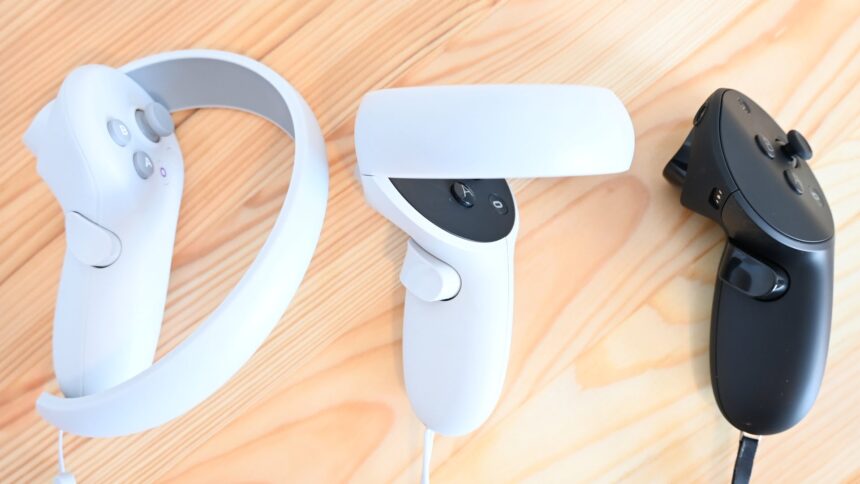
Comparison view of the VR controllers from left to right: Pico 4, Quest 2, Quest Pro. | Image: MIXED
The camera tracking also has drawbacks. It takes a few seconds before the controllers are ready for use. Reports suggest, this could have been fixed with one of the latest updates. In addition, problems with apps sometimes interrupt the tracking. Then the controllers have to be restarted. In one case, for example, I went out of the Guardian system in the MR demo "The World Beyond", which crashed the app and controller tracking.
According to Meta, the controllers implement a new feedback technology called TruTouch. Unlike the touch controllers, which usually produce a kind of general vibration, the haptic impulses of the Pro controllers are better defined and relatively strong. The Pro controller's permanently installed batteries last for about six hours, and charge via the docking station or an included charging cable.
Christian Steiner, MIXED Hand tracking gives me the impression that it works on a Quest 2 level. Good, but not good enough for me to use it in the future.
The new controllers feel absolutely premium. They are a bit heavier than the touch controllers, but feel great in my hands even during longer sessions. Equipping the controllers with tracking cameras and a Snapdragon processor, so they can orient themselves independently in space, is a great idea. Studios and agencies can develop much more natural applications with the larger tracking volume.
This may be less noticeable in gaming, as game design can adapt to the technology, and tricks have been used in the past to suggest you can work behind your back (such as pulling arrows or grabbing a shield). Whether the controllers play a role in gaming at all remains unclear. After all, VR games have to be optimized for different input devices and platforms - will special use cases be made possible only for a few Pro controller owners?
For the B2B world and especially in the VR training sector, however, there are many actions based on reality that do not take place in the field of view of the tracking cameras and previously had to be implemented with abstract UI integrations. That's no longer necessary.
Sound, Software, & the Quest Store
Sound via integrated speakers seems a bit better than on the Quest 2. There is a jack plug on both sides of the head mount so those who need perfect sound can connect headphones. The microphone solution is good and voice is transmitted clearly and cleanly but with occasional popping and distortion.
Meta is still the benchmark when it comes to software, at least in terms of the general offer and functionality. Bugs and dropouts occur from time to time with functions associated with passthrough. There are also conflicts between the manual drawing of my physical space (walls, table, etc.) and Horizon Workrooms. If I already drew a virtual table in my room setup, Workrooms snags right at the beginning configuring the table.
No useful applications exist yet for eye and face-tracking. This is perhaps the strongest indication that the Quest Pro is primarily a dev kit, demoing new technologies and enabling the creation of apps for the Quest 3 or other upcoming VR headsets.
The Quest Store offering is currently the largest on the market, at least if I go by the standard library. There is not much for companies, not even in the store category for Quest Pro. This again confirms the impression that it is primarily a dev kit that has its place in companies when they develop their own applications for it.
Christian Steiner, MIXED: The good sound of the Quest Pro is mentioned far too seldom. The integrated speakers near the ear provide an atmospheric sound in most applications. Voices transmit clearly, soundscapes in apps surround me evenly, and I play various VR games with pleasant sound quality.
Unfortunately, I am still looking in vain for software to test the Quest Pro features. There is a separate Quest Pro category in the new Quest Store, which is also coming soon for Quest 2, but it is easy to miss. It also offers more games than I would like for a business headset like Quest Pro.
Where's a "First Steps: Quest Pro?" Where is an application with a near photo-realistic avatar to get a better sense of face-tracking? Quest Pro's software launch couldn't have been more unspectacular.
Wireless and wired PC streaming
In the test, Air Link had no problems with Quest Pro. The wired connection also works flawlessly. SteamVR or content from the Rift store streams as usual.
Quest Pro: Privacy
The Facebook account requirement is history. I "only" need a Meta account connected to my Quest headset. An additional Meta Horizon account is eventually necessary for using various apps from Meta Platform Technologies (MPT).
Meta collects and processes data on the Quest Pro just as on the other Quest devices. This includes hand, eye- and face-tracking data in addition to interaction data. Corresponding privacy agreements necessary for use display in the VR headset when activating features. Raw image data remains on the device according to Meta's privacy policy. This also applies to image data of the environment when using mixed reality features, audio, and fitness data.
Furthermore, Meta collects technical data when using the VR headset, as well as data from partners and third parties, such as app providers. Meta uses the data to, among other things, send personalized commercial content, provide personalized content suggestions, and display advertisements, offers, and sponsored content in MPT products.
Every user of Meta's services must be aware that data collection is a core part of Meta's business model. This data is used, for example, to serve personalized advertising. This means that the data is used by a US corporation for commercial purposes. If you do not want this, you should not use Quest devices and Meta services.
Quest Pro review conclusion: Fascinating, immature technology offers a glimpse of the future
To answer the question about the benefit for consumers right away: $1,800 is an exclusion criterion for private use. There are not yet enough applications for that. However, it is an interesting XR headset for rich VR enthusiasts and so-called early adopters.
The picture is better than that of the Quest 2 and Pico 4, even without a higher resolution, thanks to new display technology and pancake lenses. There is no ghosting, no glares, no God Rays - just a sharp picture from edge to edge. Color passthrough is impressive due to depth correctness. This makes exciting MR concepts possible that demonstrate the great potential of the technology.
But that's already the downside of the Quest Pro. Low resolution of the cameras and the color overlay, limit the headset's potential, especially in terms of productivity. Working on and around physical monitors is not possible with the low camera resolution and the limited battery life. This is different for MR modes of VR games - Quest Pro has an advantage over the Quest 2 versions due to the color passthrough.
Eye and face tracking are nice, but nothing more. We still have to find useful application areas.
- Comparison: Quest 2 with Elite Strap (left), Quest Pro (right).
- Comparison: Pico 4 (left), Quest Pro (right)
The Pro controllers make a difference. They are more compact and track reliably - if they do not crash due to software problems, which rarely happens. This and the good haptic feedback also make them an expensive but excellent alternative for the touch controllers (compatible with Quest 2 from December 2022).
The Quest Pro moves towards ski goggles in terms of form factor, away from the previously boxy face-computer. Still, it's heavier than the Quest 2. I find the head mount both good and bad. While it is comfortable in the back, the pad on the forehead gets uncomfortable fast. For future VR headsets, I strongly recommend Meta to go for interchangeable head mounts like they did with the Quest 2.
Apart from the comfort and the cameras used, most of the Quest Pro's shortcomings stem from software issues, such as bugs and performance problems. The experience with Meta software suggests that significant improvements in the upcoming months.
At first glance, the Quest Pro seems less spectacular than expected. A closer look reveals significant progress, which makes the vision of the Metaverse demonstrable for the first time. Though, this is not sufficient for everyday use at a price of $1,800. Meta Quest Pro is foremost a dev kit with a lot of untapped potential with various updates and new applications.
Christian Steiner, MIXED: Currently,Meta aims the Quest Pro at agencies and studios developing their first MR applications with the new color passthrough and experimenting with it.
Large teams with the capacity to develop their own MR applications should already have some devices. Home users, in my opinion, are better off leaving the Quest Pro alone. The price difference between Quest Pro and a heavily subsidized Quest 2 is not justified by the improved optics, seamless self-tracking controllers, and accessories like the charging station.
Quest Pro Datasheet
Note: Links to online stores in articles can be so-called affiliate links. If you buy through this link, MIXED receives a commission from the provider. For you the price does not change.

